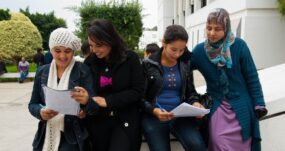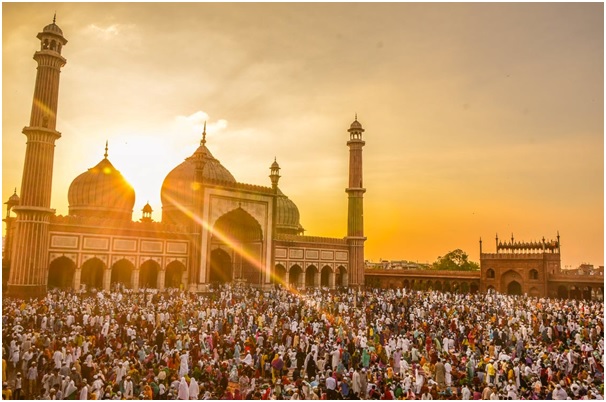
American Muslim Landscape: By the Numbers
By Mohamad Chehade, PhD
If you are targeting the American Muslim community for your next product or service, it is important to understand them better. In this article, we will have a deeper insight into the American Muslim landscape, so you are aware of your target audiences.
America’s Muslim population is growing at a rapid rate. According to the Pew Research Center, about 3.45 million Muslims of all ages lived in the US in 2017, making up about 1.1% of the total U.S. population. However, this figure has grown enormously over the years. It is expected that the Muslim community will reach 8.1 million in 2050, surpassing Jews as the second-largest religious group.
With this increase, there are many opportunities for marketers to reach the Muslim market, but this requires a deep understanding of the American Muslim landscape.
Muslims in the US
The United States witnessed the largest increase in the Muslim population between 1991 and 2012. Approximately 1.7 million Muslims entered the country as legal permanent residents. About 72% of the American Muslim population is the second generation.
Here are ten states with the largest Muslim population:
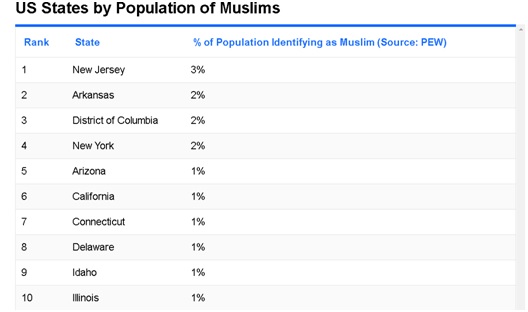
Detroit, Michigan
According to a study, Muslims constitute about 2.75% of the Michigan population. More than 15% of the doctors in Michigan are Muslims. More than 10% of all are pharmacists, and 7% of all are dentists. In 2013, immigration to Hamtramck from Yemen, Bangladesh, and Bosnia brought in enough new Muslims to make it the first Muslim-majority city.
Muslims have contributed heavily to the state’s economy. A Muslims for American Progress (MAP) study found that Muslim-owned businesses employed more than 100,000 people in the state in 2015. Muslims also spent more than $5.5 billion in the state’s economy that same year.
American Muslims in the state are a well-educated group and spent about four times more on education than Americans in general. In 2015, Muslims owned 35,835 businesses or about 4.18% of all small businesses in Michigan. In 2016, they accounted for about 15% of all medical doctors in the state.
Chicago, Illinois
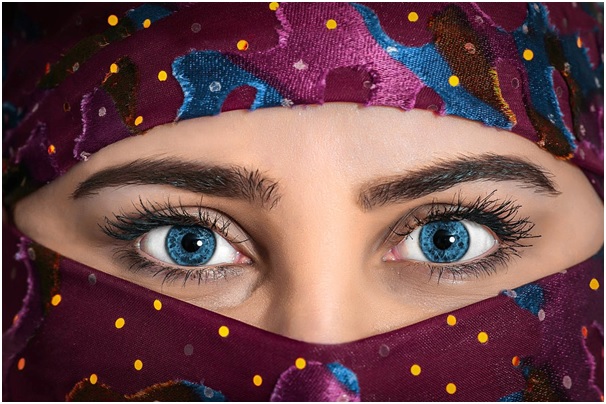
The Council on American-Islamic Relations (CAIR) estimates Chicago’s Muslim population at between 300,000 and 500,000 people, or between 3 percent and 5 percent of the city’s population, although that number varies. This has led to economic growth, as the city builds mosques and various institutions and adapts to provide more services for Muslims.
“Chicago is a diverse place that sets itself up as a welcoming city and provides services (to new immigrants). In communities, we see a number of new mosques pop up every year,” said Sufyan Sohel, deputy director and counsel of CAIR. “As the population grows, they see more of a need for these services that may not have been priorities before.”
Ihsan Bagby, an associate professor of Arabic and Islamic studies at the University of Kentucky who conducted a 2010 study on Muslims in the area, says that with Islam being the fastest-growing religion in the US, the Chicago area likely saw a 25% increase in the number of mosques in the last decade.
New York City, New York
Muslims made up about 8.96% of the New York city’s population in 2016. That’s about 768,767 Muslims in the NYC metro area, which has a total population of around 8,583,000.
Medicine is one area in which Muslims unquestionably affect NYC. Muslims contribute significantly to healthcare in the city, comprising 9.7% of doctors, 8.6% dentists, and 12.5% of pharmacists. These Muslim medical professionals support around 36,000 jobs and pay more than $384 million in state and local taxes.
They are also popular in STEM (Science, Technology, Engineering, Math) fields, with the ISPU study finding that about 11.3% of engineers in New York are Muslims. Around 9,497 teachers in public K-12 schools in NYC are Muslim as well.
Los Angeles, California
Muslims are about 1% of the population of Los Angeles, a city known for its diversity.
“The Muslim community is the most diverse in terms of their ethnic backgrounds in the United States,” says Shakeel Syed, Executive Director of the Islamic Shura Council of Southern California. “So they come from all continents, all places.”
Syed notes that it’s important not to generalize the whole local Muslim population, as Muslims from different cultures may have different practices and customs.
“Is there diversity in the perspectives, in the things they do and don’t do?” Syed says. “Absolutely, yes.”
Race and Ethnicity of American Muslims

America is a country of immigrants, and this is often true for Muslims in America. Three-quarters of US Muslims are immigrants or children of immigrants. About 58% are first-generation Americans, having been born in another country. Of those born in other countries, about 35% immigrated from South Asia.
Ethnically, Muslims are a diverse group, with no one group forming a majority of Muslims in America. About 41% are white, including those who identify as Arab, Middle Eastern, and Persian/Iranian. About 28% are Asian, 20% black, and 8% Latino.
Education
Overall, Muslims are a well-educated group, with Muslim women leading the way. About 73% of American Muslim women and 57% of American Muslim men have some post-high school education. 31% have at least a bachelor’s degree. Worldwide, Muslim men are more likely to have post-secondary education than women. Still, in some regions, including North America, the gap has closed or even reversed in recent years, with more Muslim women achieving college degrees.
Income and Professions
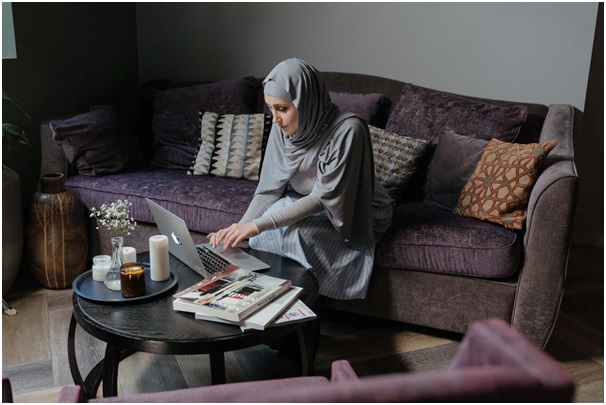
According to Pew data, US Muslims are about as likely as the overall American population to have an income of $100,000 or higher (24% of Muslims and 23% of Americans in general). However, 40% of Muslim Americans report household incomes under $30,000, compared with 32% of Americans as a whole. Another 35% of Muslims report middle-class incomes between $30,000 and $99,999, compared with 45% of all Americans.
While Muslims are somewhat less likely to fall into the middle-class category than Americans in general, they are also less likely to own a home. This is possibly related to somewhat lower incomes but may also be due to age—about 35% are between the ages of 18 and 29. Probably, younger Muslims are waiting to finish school or find a job in a different area before purchasing a home.
As several ISPU studies show, many Muslims work in the health and science fields, accounting for 15% of medical workers in Michigan, and nearly 10% of doctors in New York City.
Another ISPU report found that about 27% of Muslim physicians in the US went to medical school in the US, while the remainder completed their education internationally. They most commonly practice in Michigan (11.5%), New Jersey (10.2%), Illinois (10.2%), California (7.5%), Texas (6.6%), New York (6.2%), and Ohio (5.3%). Muslim physicians are even more likely to be immigrants than the US Muslim population as a whole, with only 19.4% reporting they were born in the US.
Muslims also work in engineering and other STEM fields, making up 11.3% of engineers in New York City, where they have worked on projects from the George Washington Bridge to coastal storm risk management.
Additionally, Muslims contribute heavily to small businesses and entrepreneurship in the US. According to another ISPU study, Muslim inventors were awarded 1,638 American patents between 2010 and 2015 alone. During that time, about 4.15% of all patents went to Muslims. In a 2011 Pew study, 20% of Muslims said they were self-employed or owned a small business.
Education is another field impacted by American Muslims. According to a 2015 study by ISPU, Muslim educators teach about 30,000 K-12 students in Michigan alone. Two social studies teachers in New Jersey, Nagla Bedir and Luma Hasan, founded Teaching While Muslim, a website designed to develop a network of Muslim educators and fight discrimination.
Age and Family Life
The US population of Muslims is overall younger than the US population as a whole. About half of Muslims in America are younger than 50, and more than a third are under 30. As this large, young segment of the population has children, it continues to grow. About half of American Muslims are married, similar to the overall US population, and they have about 2.4 children.
Generation M
Generation M is a term for the rapidly-growing segment of young, educated, and affluent Muslims in the US and urban cities (or major metropolitan cities) around the world. They wield tremendous buying power in today’s consumer market, and as a result, many brands attempt to market to Generation M, but research shows these efforts aren’t always successful.
In one study of Muslim American consumers, 98 percent of respondents said they believe “American brands don’t actively reach out to Muslim consumers.” 80 percent said they would prefer to buy brands that support Muslim identity through promotion and celebration of religious festivals. A majority of respondents also said they wanted global companies to make more of an effort to understand Muslim consumers, and that they would like to see a wider range of products specifically appealing to Muslims.”
Alia Khan, the founder and chairwoman of the Islamic Fashion and Design Council, says members of Generation M believe in modernity while still upholding their faith. “Generation M is a particular segment within the wider global Muslim population. One key defining characteristic is that they believe faith and modernity go hand in hand. We are focusing on quality, ethics, and sustainability, which are important parts of the halal lifestyle that need to be conveyed into the product, and good starting points for anyone in the market.”
For example, while some Muslim women appreciated the Nike Pro Hijab line, others still expressed concern about the company’s reported previous use of sweatshop labor. “Muslim women are willing to do the extra work, ensuring that brands respect their lifestyle choices and decisions at every step,” says Nayantara Dutta, a trends researcher for J. Walter Thompson’s Innovations Group.
As Generation M grows and earns larger salaries, its purchasing power is also expanding. Overall, Gen M is young, educated, and affluent, providing opportunities to savvy marketers who know how to reach them. Unfortunately, many companies trying to appeal to Muslim consumers miss the mark, which is why it’s important to research specific markets within the US Muslim community carefully.
The modest fashion industry, for example, is worth $254 billion worldwide, but many marketers have tripped up trying to sell these products to Muslim consumers, particularly in the US. Often Muslims, especially younger ones, feel that companies want to sell them something while failing to understand their needs and wants.
Critiquing D&G’s collection of abayas (a cloaklike outer covering many Muslim women wear), Requaiya Haris wrote in the Guardian, “This range rather looks like an appropriation of existing traditions without giving them any real recognition.”
Effects of Growing Muslim Population in the US
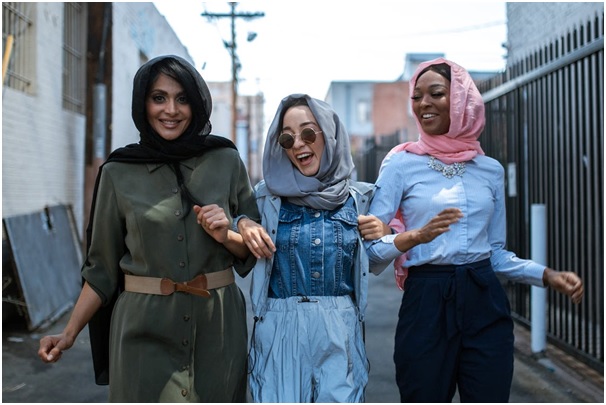
As we saw from Michigan’s data, Muslim business owners contribute strongly to the local and national economy. In 2013, Chris Blauvelt, Omar Amid, and Amany Killawi jointly founded LaunchGood, the world’s largest faith-inspired crowdfunding platform to support Muslim entrepreneurs. Other notable Muslim entrepreneurs include Jawed Karim, who co-founded YouTube, Jacksonville Jaguars owner Shahid Khan, and Sheeran Sabet, who founded Splashgood to provide modest scuba diving outfits.
As the number of Muslims in America continues to grow, so does this large and varied group’s buying power. Globally, the Muslim market is equal to the economy of the world’s third-largest country. According to a 2017 report, the largest segment is Islamic finance, at $2 trillion, followed by halal food and beverages at $1.24 trillion. Modest fashion is a $254 billion dollar market, followed by Muslim media and recreation at $198 billion, travel and tourism at $169 billion, and halal pharmaceuticals at $83 billion.
A recent study revealed that the halal food market in the US is expected to grow by $8.17 billion between 2020 and 2024, progressing at a CAGR of 5%.
Islamic finance, which conforms to Islamic laws about loans and other financial arrangements, is also a growing sector. According to the World Bank, the Islamic finance industry has expanded quickly over in recent years, growing at 10-12% annually. Globally, Sharia-compliant financial assets are estimated at about $2 trillion US dollars—this number includes bank and non-bank financial institutions, capital markets, money markets, and insurance. In fact, Islamic finance is the largest segment of the global Muslim market, followed by halal food.
Although Muslim-majority countries like the UAE and Saudi Arabia lead the list of countries with the most Islamic finance assets, the growing number of Muslims in the US still presents an increasing need for these services. American academics are devoting more time for Islamic finance education. Between 2015 and 2017, the country produced 55 peer-reviewed articles and 43 research papers on the subject. Globally recognized universities in the US, UK, and Australia are now offering degrees in Islamic finance.
Final Thoughts
In marketing to Muslims, it is always important to study your target market and understand their needs and wants, so you don’t miss the mark with consumers. Remember that Muslims from different cultures or parts of the world may have different practices and preferences, so a one-size-fits-all approach is not a good plan.
If your company is interested in targeting Muslim consumers in the US, you need to consumer the specific subgroups who may be interested in your product, such as Generation M, Muslim women between the ages of 25 and 35, Muslim men between the ages of 35 and 45, etc. Other demographics such as income, marital status, and occupation may also be important depending on your product. Once you’ve determined your target market, use market research to determine what these groups want or need in products like yours, then use product testing to learn how they respond to your particular product. MLC Media is always available to assist clients with this process.
References
- New Estimates Show US Muslim Population Continues to Grow, by Besheer Mohamed. Pew Research Fact Tank, January 3, 2018. Available at: https://www.pewresearch.org/fact-tank/2018/01/03/new-estimates-show-u-s-muslim-population-continues-to-grow/%20
- Muslims in America: Immigrants and Those Born in the US See Life Differently in Many Ways. Pew Research Center, April 17, 2018. Available at: https://www.pewforum.org/essay/muslims-in-america-immigrants-and-those-born-in-u-s-see-life-differently-in-many-ways/
- In the First Majority-Muslim US City, Residents Tense About its Future, by Sarah Pulliam Bailey. The Washington Post, November 21, 2015, available at: https://www.washingtonpost.com/national/for-the-first-majority-muslim-us-city-residents-tense-about-its-future/2015/11/21/45d0ea96-8a24-11e5-be39-0034bb576eee_story.html
- An Impact Report of Muslim Contributions to Michigan, by Muslims for American Progress. Available at:
https://static1.squarespace.com/static/584f0e56ebbd1ae235d63da5/t/
58fe45916a4963418dc111bf/1493058971264/
What+Would+a+Michigan+Without+Muslims+Look+Like%3F.pdf - An Impact Report of Muslim Contributions to New York City, by Muslims for American Progress, July, 2018. Available at: https://static1.squarespace.com/static/584f0e56ebbd1ae235d63da5/t/
5c06ad970e2e723b23468099/1543941565346/MAP-NYC-Report-Web.pdf - Growing Muslim Population Means More Services to Keep Up, by Rachel Hinton, Chicago Sun Times, July 9, 2017. Available at: https://chicago.suntimes.com/2017/7/9/18332417/growing-muslim-population-means-more-services-to-keep-up
- Study Shows Islamophobia Is Growing In The U.S. Some Say It’s Rising In Chicago, Too, by Esther Yoon-Ji Kang, May 3, 2019. Available at: https://www.wbez.org/stories/study-shows-islamophobia-is-growing-in-the-us-some-say-its-rising-in-chicago-too/d841d84c-14ee-4a71-8f34-cbdb185d22aa
- SoCal’s Muslim Community Geographically, Ethnically Diverse, by Aaron Mendelson, KPCC News, December 11, 2015. Available at: https://www.scpr.org/news/2015/12/11/56162/socal-s-muslim-community-geographically-ethnically/
- The Muslim Gender Gap in Educational Attainment is Shrinking, Pew Research Reports, available at: https://www.pewresearch.org/fact-tank/2016/12/27/the-muslim-gender-gap-in-educational-attainment-is-shrinking/
- A Window Into American Muslim Physicians: Civic Engagement and Community Participation, by Muslims for American Progress, September, 2012, available at: https://www.ispu.org/wp-content/uploads/2016/09/ISPU_Report_Muslim_Physicians.pdf
- Muslim Americans: No Sign of Growth in Alienation or Support for Extremism, Pew Research, August 30, 2011, available at: https://www.pewresearch.org/politics/2011/08/30/muslim-americans-no-signs-of-growth-in-alienation-or-support-for-extremism/
- ‘Unapologetically Muslim’: Study Investigates Trends Amongst Muslim Women in US, UK, and Indonesia, by Bennett Bennett, The Drum, March 2, 2018, available at: https://www.thedrum.com/news/2018/03/02/unapologetically-muslim-study-investigates-trends-amongst-muslim-women-us-uk-and
- American Muslims Continue to Contribute to the US Economy, by Michael Verchot, University of Washington’s Foster Blog, available at: https://blog.foster.uw.edu/american-muslims-contribute-us-economy/
- Understanding Spending Habits and Buying Behavior of the American Muslim Community: A Pilot Study by Oral Capps, Jr., Asma Ahad, and Peter S. Murano, for Food Distribution Research Society, available at: file:///C:/Users/Vivian/Downloads/JFDR_48.3_04_Capps%20(2).pdf
- The World’s Muslims: Religion, Politics and Society, Pew Research, April 30, 2013, available at: https://www.pewforum.org/2013/04/30/the-worlds-muslims-religion-politics-society-overview/
- Islamic Finance brief, The World Bank, March 31, 2015, available at: https://www.worldbank.org/en/topic/financialsector/brief/islamic-finance
- Islamic Finance Development Report 2018, available at: https://ceif.iba.edu.pk/pdf/Reuters-Islamic-finance-development-report2018.pdf
share:



